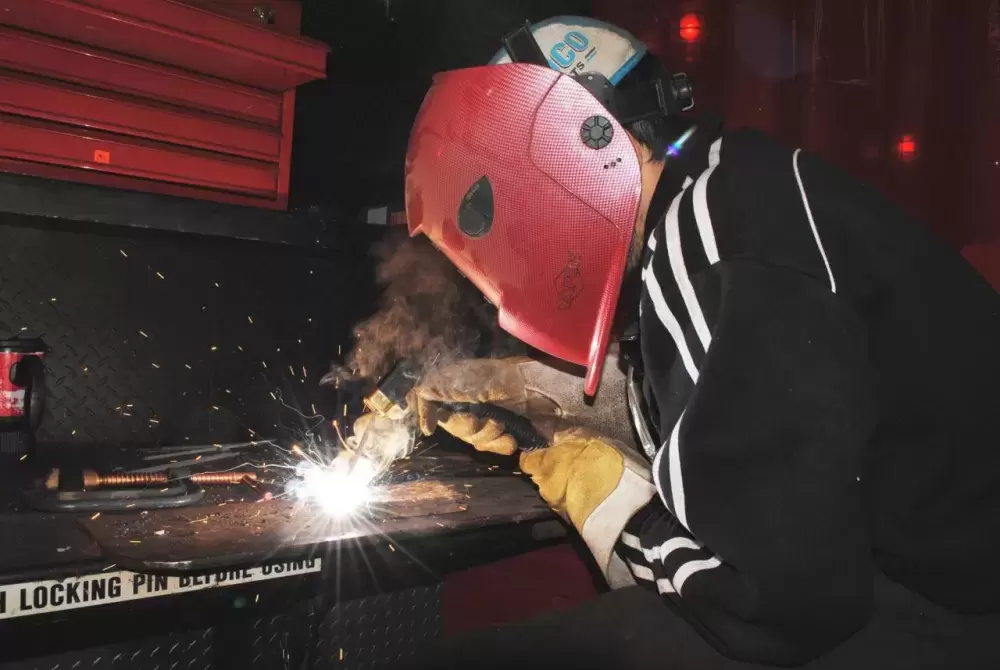A group of 15 First Nations students ranging from age 17 to 45 are nearing the end of a month-long training program called Bridging to Trades.
It’s a partnership between the Nuu-chah-nulth Employment and Training Program (NETP), Nicola Valley Institute of Technology (NVIT) and Vast Alternative School, with NVIT providing the instructors and a state-of-the-art mobile training facility parked in the old BC Hydro yard on Wallace St.
“They’ve done two weeks so far, with welding in the trailer and electrical in the building,” said employment counsellor Andy Callicum of NETP just before Spring Break. “Next week, it’s millwright and plumbing/pipefitting.”
During the first session, the students all successfully completed Math 11. While most Alberni Valley students were off for spring break, these trainees hit the books for another mandatory classroom subject.
“They came in without high school diplomas, so they’re going to take English to complete their GED (diploma equivalent),” Callicum said.
NVIT instructor Mike Hassel said he and his partner Bill Kerr each worked in their trades for 30 years before moving into teaching. Hassel said the goal of the program is to improve the options available to the students.
“The object is to have them ready for college placement,” he said.
Kerr said there is already a huge demand for skilled tradespeople and it is only going to get bigger.
“In a survey a few years ago, the average age for a journeyman electrician in B.C. was 55. They’re all getting ready to retire,” Kerr said.
For those who are serious about pursuing the construction trades on major projects, it does mean remaining mobile, he said.
“We remind people that ‘journeyman’ means journeying. There’s a lot of travel,” Kerr said.
Kerr said part of the goal is to instill that sense of pride that comes from contributing to a large, visible project.
“I worked throughout B.C. and there are a lot of major projects that I worked on. The last was the wind turbine up on Grouse Mountain,” he said
Callicum said some of the students prepared for the program by taking pre-employment skills training.
“They build up confidence and self-esteem, as well as learning workplace skills such as document skills and literacy,” he said.
Once the students complete the course, they are eligible for apprenticeship programs in one of the four trades.
“Hopefully, they come out with a leg up on a program and a desire to pursue it further,” Callicum said. “Most of the older workers have worked as laborers in the construction industry, but not in the skilled trades. Hopefully, we’ll get them past that hurdle.”
Hupacasath First Nation member Johnson Hamilton, 39, said he fits into that category.
“I’ve worked in construction for the last 20 years, basically doing everything,” Hamilton said. “I got involved in this program to continue with my education, because if you don’t have certification, your career flatlines.”
Without a high school diploma, it is impossible to obtain an apprenticeship, and without achieving certification, it is impossible to get the high-paying jobs. Hamilton said in the meantime, his experience working alongside certified plumbers and electricians will not go to waste.
“I’m a good listener and I learned a lot on the job,” he said.
Tla-o-qui-aht member Denise Amos is the only woman in the class. Amos said she started a family at an early age and did not complete high school. For that reason, she said she is especially proud of the ‘A’ she attained in Math 11.
“What’s really nice is the effect it’s had on my younger children, Grade 4 and Grade 1. I haven’t had to tell them to do their homework, because they’re working at it every night,” Amos said.
She said she is used to working in heavy industry, but the trades have been a revelation.
“I work at the Iisaak sawmill, grading and working on the chop saw,” she said. “I wasn’t liking the welding at the beginning, but I did get to like it and I did well on the tests. I think I’d be able to keep a boat afloat.”
Amos said she really enjoyed the electrical training and felt confident with her work. As for whether she will decide to pursue an apprenticeship in one of the trades, she added, “I’ll know more after I do the other two.”
At 23, Uchucklesaht Tribe member Christopher Cenname said he has bounced around the industry for a few years, and is now determined to pursue a trade.
“I used to do asphalt work, and I was up in Alberta on the oil rigs. I used torch-tools up there,” Cenname said. “This is an awesome program. I’m getting to try out all these options.”
Callicum said many people have the mistaken idea that NETP only serves Nuu-chah-nulth members. Not so, he said.
“We are here to serve any aboriginal person living in Nuu-chah-nulth territory, whether they are First Nations, Inuit or Metis,” he said.
For more information about the Bridging to Trades program, or to inquire about available graduates, contact Andy Callicum at 250-723-1331 or visit the Ha-Shilth-Sa Website to find information about the program at http://www.hashilthsa.com/jobs/bridging-trades-program-aims-ensure-future-success







